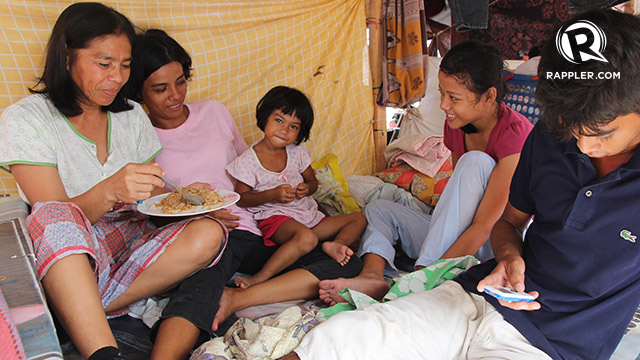SUMMARY
This is AI generated summarization, which may have errors. For context, always refer to the full article.

MANILA, Philippines – Seven months after the Moro National Liberation Front’s (MNLF) siege, thousands of internally-displaced people (IDP) still live in evacuation camps in Zamboanga City. Adding to the misery of the evacuees, a new report – that alarmed government officials – claimed rampant prostitution in the evacuation camps (ECs) contributing to cases of sexually-transmitted diseases among IDPs.
In a press conference on Monday, April 14, Zamboanga City health officer Dr. Rodel Agbulos denied allegations of existing prostitution activities and brothels inside the evacuation centers.
Agbulos admitted, however, that such activities happened inside the camps in the first 2 months after the siege, when a city-wide curfew was imposed. He said freelance sex workers displaced by the siege were camped in ECs and continued their work there.
Since the curfew was lifted and after a series of inspections in the camps, freelance sex workers have returned to the streets outside the camp, Agbulos said. There are also no brothels inside the ECs as confirmed by the Department of Social Welfare and Development (DSWD).
STD cases
A city hall staff, who refused to be named, said that the STD cases in the grandstand cannot be directly linked to prostitution in camps as these cases had existed even before the siege occured.
The City Health Office’s (CHO) health inspection from March to April only found 2 patients who tested positive for STDs.
“We are not trying to hide any figures. We are not trying to hide any statistics, but this is just based on our office’s assessment,” Agbulos said.
The CHO has been rescuing and conducting pap smears for women to control sexually transmitted infections in the city.
Relocation efforts

Latest findings show that there are still 23,000 IDPs requiring assistance in evacuation centers and transitional sites in Zamboanga. The city government has been pursuing relocation, but IDPs said efforts have been “slow.”
The rehabilitation and housing budget comes from the national government and goes directly to the projects.
Before a project is finalized, it must undergo the proper bidding process for implementation which takes a certain amount of time. The National Housing Authority (NHA), alongside concerned agencies, could not start with the housing projects unless it is approved.
One project has already been approved – the Banera Resettlement – which would is hoped to be finished by the end of April 2014. (READ: Zamboanga: The forgotten crisis)
Clarification
Home-based IDPs have heard talks that they will be transferred to resettlement shelters.
During the 5th information caravan series at the City Coliseum on April 15, Mayor Maria Isabelle “Beng” Climaco clarified, “[The] City Government of Zamboanga has not promised houses for the home-based [IDPs] because you already have a home.”
She said IDPs who are renting their houses are not exempted because they have the “capacity to rent.” The bunkhouses being built are for those in evacuation centers who are in poor health condition.
Housing assistance prioritizes house and lot owners, followed by the sharers, and lastly the renters.
The Information Caravan series is held by the local government to answer gaps in information between IDPs and service providers.
‘No’ to relocation?
Meanwhile, not all IDPs are in a hurry to leave evacuation camps just yet.
Vilma Duhani, a 53-year-old IDP and one of the makeshift store owners at the Don Joaquin Enriquez Memorial Sports Complex, said the relocation is a slow-dragging process of rebuilding their lives again in a far-flung community like Taluksangay, which is 19 kilometers away from the city proper.
Abdullah Wahab, a Badjao from Mariki, said that the government should relocate them beside the sea, as fishing is the Badjao’s main source of living. (READ: The Badjao of Zamboanga: Victims of war and relocation)
In the meantime, IDPs have to depend on the government’s relocation efforts.
“The city government promised that we (can) only stay here [in the grandstand] for a maximum of 18 months,” Tausug IDP leader Alseyd Jauhari said.
“They promised that they’ll return us to our homes. If their promises will be broken, then it’s their choice,” he added.
Government’s assurance
The local government has been transferring IDPs situated in the city’s shoreline to more suitable evacuation centers.
The relocation of IDPs from the Cawa-Cawa shoreline to Mampang and Arena Blanco elementary schools has been “orderly and peacefully,” Climaco said on Monday, April 14.
Dr Elmeir Apolinario, assistant city administrator and head of the temporary shelter cluster, added that the city government shall shoulder the school facilities’ repair expenses once the IDPs are transferred to the bunkhouses being made.
“Don’t forget to smile always even if we don’t have a house,” Climaco concluded in Chavacano at the information caravan. – Rappler.com/with reports from Francis Sadaya
Regine Mendoza is a Rappler intern from Ateneo de Zamboanga University.
Add a comment
How does this make you feel?
There are no comments yet. Add your comment to start the conversation.